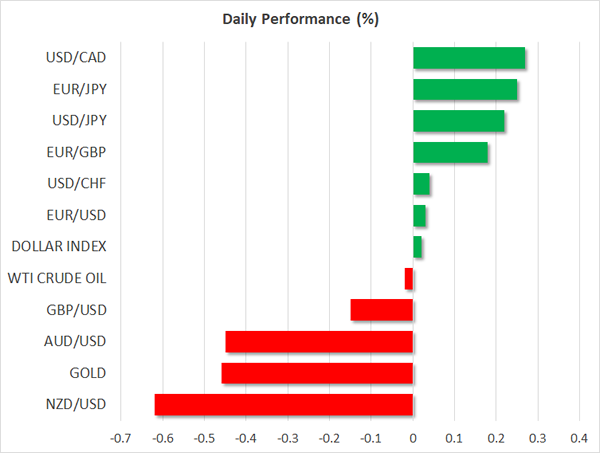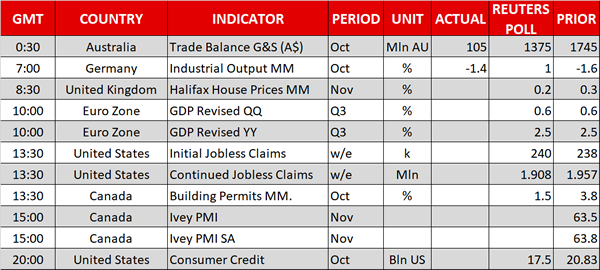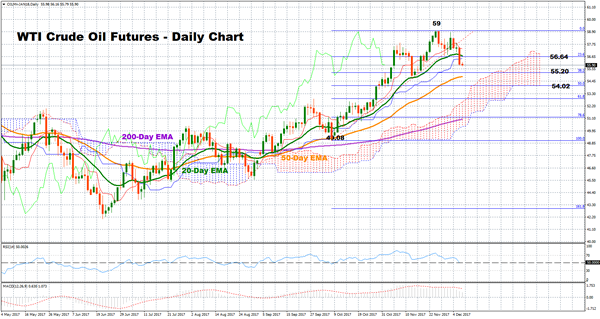Here are the latest developments in global markets:
FOREX: The dollar hit a two-week high against a basket of currencies as optimism on US tax reform continued to support the currency, though concerns over a possible government shutdown restricted steeper upside movement. The euro and the pound were on track to post the third day of consecutive losses versus the greenback, while the loonie tumbled to a one-week low after the BOC expressed caution for further rate hikes. The aussie tumbled in the wake of worse-than-expected Australian trade data.
STOCKS: The Nikkei rebounded after yesterday’s sharp fall, closing 1.45% higher; stocks in mainland China recorded losses though. Euro Stoxx 50 futures traded 0.2% higher at 0751 GMT. Dow and S&P 500 futures were up by 0.1% and Nasdaq 100 equivalents traded higher by 0.4%.
COMMODITIES: Oil prices were trading near three-week lows touched yesterday following the release of the EIA report on US crude inventories. US crude stocks fell more than expected but gasoline and distillate inventories surged past forecasts. WTI crude and Brent were flat at $56.00 and $61.35 per barrel respectively. Gold retreated to a four-month low of $1,256.02 an ounce (-0.47%).

Major movers: Loonie loses ground on perceived BOC dovishness; antipodeans also down after Australian trade data drag
The loonie was on the backfoot during Asian trading, pushing dollar/loonie to a one-week high of 1.2824 (+0.30%) after the Bank of Canada held interest rates unchanged on Wednesday at 1.0% but remained cautious on future rate increases despite upbeat evidence on employment the previous day. The monetary policy statement following the decision stated that “while higher interest rates will likely be required over time”, upcoming data will determine the path of monetary policy, giving no clue about when the central bank will further normalize policy. Hence, investors priced that a hike in January will be less likely.
Meanwhile in the US, Senate Republicans and House policymakers agreed on Wednesday to extend talks on the tax overhaul, raising hopes that differences between them could be resolved soon. Dollar/yen climbed to 112.60, while euro/dollar was hovering around a two-week low of 1.1790, pressured by disappointing German data on industrial production released earlier today. Pound/dollar was close to one-week lows at 1.3338, being weighed by weakening momentum for a breakthrough in Brexit talks.
The aussie and the kiwi dipped into losses after Australia’s October trade surplus narrowed to A$0.105 billion compared to the forecasted A$1.410bn. Exports fell by 0.3% m/m after a rise of an equivalent percentage in September, and imports increased by 2.0%. The aussie dived to a six-month low of 0.7522 (- 0.54%) to $0.7522 and the kiwi sank to a one-week low of $0.6833 (-0.64%).

Day ahead: Beyond politics, eurozone GDP, US jobless claims and Canadian building permits on today’s calendar
The eurozone will see the release of revised third quarter GDP growth figures at 1000 GMT. The numbers are expected to remain unchanged relative to the initial estimates of growth which pointed to quarterly growth of 0.6% and annual expansion in the order of 2.5%.
Out of the US, weekly jobless claims – initial and continued – due at 1330 GMT will be gathering attention. The number of initial benefits claimants for the week ending December 1 is anticipated to be 240k, little changed from the preceding week’s 238k. The world’s largest economy will also see the release of October consumer credit data at 2000 GMT.
Canadian building permits for the month of October and the country’s November Ivey PMI due at 1330 GMT and 1500 GMT respectively are also considered of relative importance and could spur movements in the loonie.
Halifax house price data out of the UK will be released within minutes. Month-on-month, prices are expected to rise by 0.2% in November. This compares to October’s rise by 0.3%.
In politics, President Trump’s action to recognize Jerusalem as the capital of Israel could generate some uncertainty; developments will be watched. US lawmakers’ efforts on tax reform will also be closely watched. Senate Republicans yesterday agreed to engage in discussions with the House of Representatives in an attempt to reconcile the two versions of the tax bill they voted in favor of; a December 22 self-imposed deadline is in place. Attempts by Congress on averting a partial government shutdown by week-end will be generating interest as well. Lastly, UK PM Theresa May might also take some initiatives to move beyond the seeming impasse in Brexit talks.

Technical Analysis: WTI crude oil futures bearish in short-term, bullish medium-term outlook intact though
WTI crude oil futures maintain a bullish picture in the medium-term but in the short-term, the market turned bearish after the price moved off the 2-½-year high of 59.0 on November 27. The RSI is currently at the 50 neutral-perceived level but is heading lower. The MACD is below its signal line and the price has crossed below the 20-day exponential moving average, hinting that negative movements might occur in the near-term.
In the dips, the market might find support at the 38.2% Fibonacci of 55.20 of the upleg from 49.08 to 59.0. From here, the 50-day EMA at 54.85 and the 50% Fibonacci mark at 54.02 could also act as barriers to downside movements.
On the upside, prices could find resistance at the 20-day EMA at 56.72, which is also the 23.6% Fibonacci level. Steeper increases could also open scope for a test at the 2 ½-year high of 59.0, while a breach of this point would paint a bullish picture in the short-term as well.












